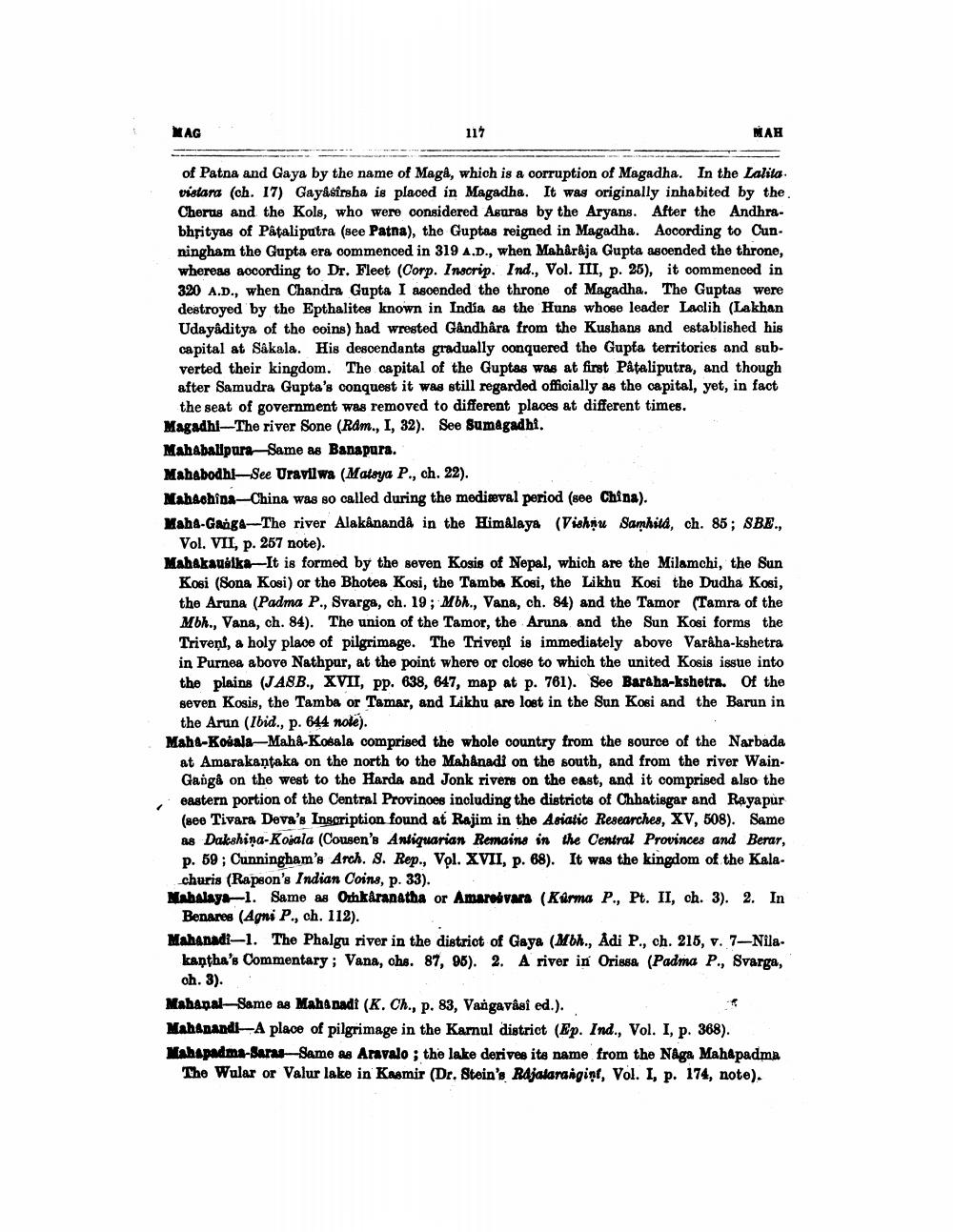________________
NAG
117
MAH
of Patna and Gaya by the name of Magd, which is a corruption of Magadha. In the Lalita vislara (ch. 17) Gayasîrsha is placed in Magadha. It was originally inhabited by the Cherus and the Kols, who were considered Asuras by the Aryans. After the Andhrabhrityas of Pataliputra (see Patna), the Guptas reigned in Magadha. According to Cun. ningham the Gupta era commenced in 319 A.D., when Maharaja Gupta ascended the throne, whereas according to Dr. Fleet (Corp. Inscrip. Ind., Vol. III, p. 26), it commenced in 320 A.D., when Chandra Gupta I ascended the throne of Magadha. The Guptas were destroyed by the Epthalites known in India as the Huns whose leader Laclih (Lakhan Udayaditya of the coins) had wrested Gåndhâra from the Kushans and established his capital at Såkala. His descendants gradually conquered the Gupta territories and subverted their kingdom. The capital of the Guptas was at first Pataliputra, and though after Samudra Gupta's conquest it was still regarded officially as the capital, yet, in fact
the seat of government was removed to different places at different times. Magadhi-The river Sone (Ram., I, 32). See Sumagadhi. Mahabalipura Same as Banapura. Mahabodhi-See Uravilwa (Matsya P., ch. 22). Mahachina-China was so called during the medieval period (see China). Maha-Ganga--The river Alakânandå in the Himalaya (Vishnu Samhita, ch. 85; SBE.,
Vol. VII, p. 257 note). Mahakauslk It is formed by the seven Kosis of Nepal, which are the Milamchi. the Sun
Kosi (Sona Kosi) or the Bhotea Kosi, the Tamba Kosi, the Likhu Kosi the Dudha Kosi, the Aruna (Padma P., Svarga, ch. 19; Mbh., Vana, ch. 84) and the Tamor (Tamra of the Mbh., Vana, ch. 84). The union of the Tamor, the Aruna and the Sun Kosi forms the Triveni, a holy place of pilgrimage. The Trivent is immediately above Varaha-kshetra in Purnea above Nathpur, at the point where or close to which the united Kosis issue into the plains (JA8B., XVII, pp. 638, 647, map at p. 761). See Baraha-kshetra. Of the seven Kosis, the Tamba or Tamar, and Likhu are lost in the Sun Kosi and the Barun in
the Arun (Ibid., p. 644 note). Mahl-Kosala-Maha-Kosala comprised the whole country from the source of the Narbada
at Amarakantaka on the north to the Mahanadi on the south, and from the river Wain. Gangå on the west to the Harda and Jonk rivers on the east, and it comprised also the eastern portion of the Central Provinces including the districts of Chhatisgar and Rayapur (see Tivara Deva's Inscription found at Rajim in the Asiatic Researches, XV, 508). Same as Dakshina-Kosala (Consen's Antiquarian Remains in the Central Provinces and Berar, p. 59; Cunningham's Arch. 8. Rep., Vol. XVII, p. 68). It was the kingdom of the Kala
churis (Rapeon's Indian Coins, p. 33). Mahalay. 1. Same as Onhkaranatha or Amare vara (Karma P., Pt. II, ch. 3). 2. In
Benares (Agni P., ch. 112). Mahanadi-1. The Phalgu river in the district of Gaya (Mbh., Adi P., ch. 215, v. 7–Nila
kantha's Commentary; Vana, ohs. 87, 96). 2. A river in Orissa (Padma P., Svarga,
oh. 3). Mahanal-Same as Mahanadi (K. Ch., p. 83, Vangavåsi ed.). Mahapandi- A place of pilgrimage in the Karnul district (Ep. Ind., Vol. I, p. 368). Mahapadma-Saras-Same as Aravalo; the lake derives its name from the Naga Mahapadma
The Wular or Valur lake in Kasmir (Dr. Stein's Rajalarangint, Vol. I, p. 174, note).




